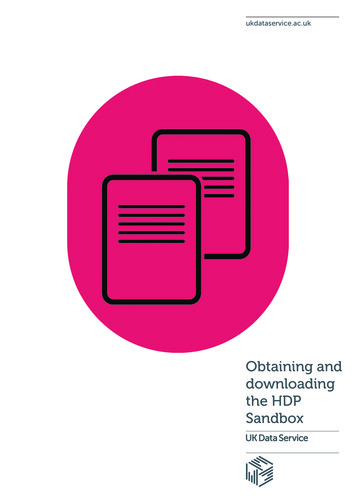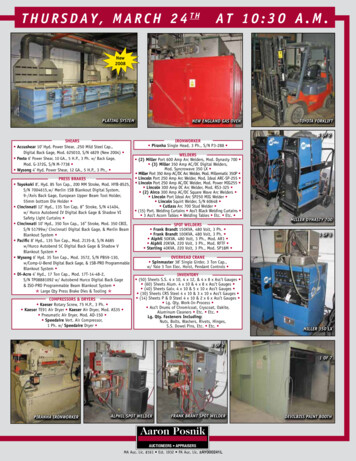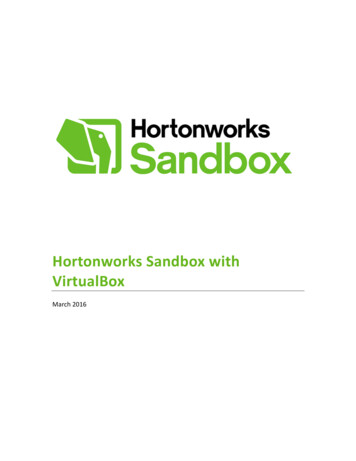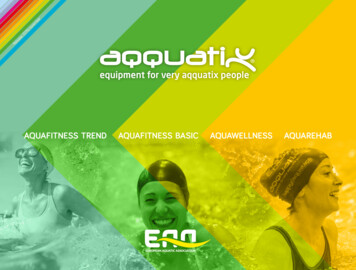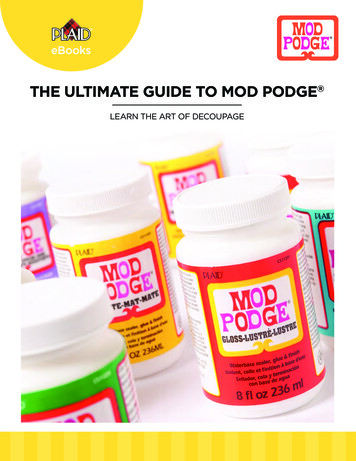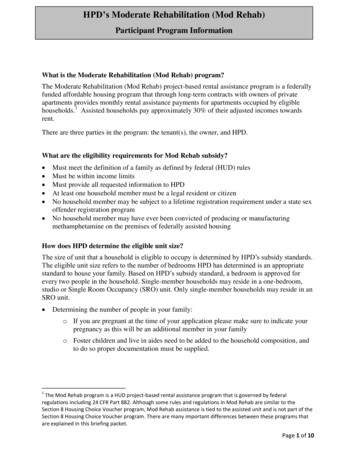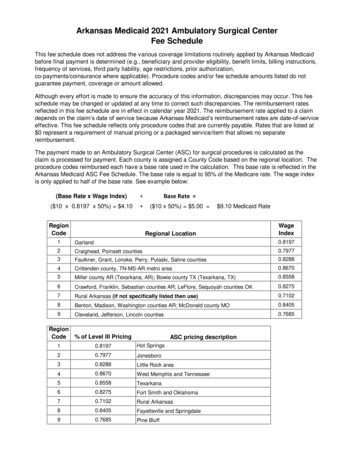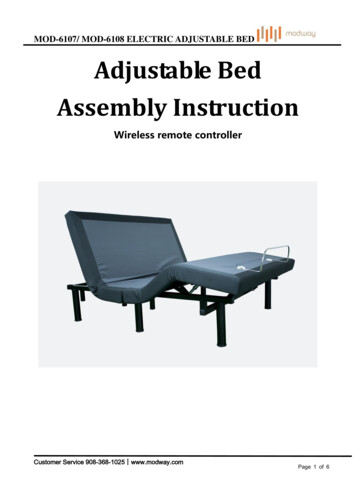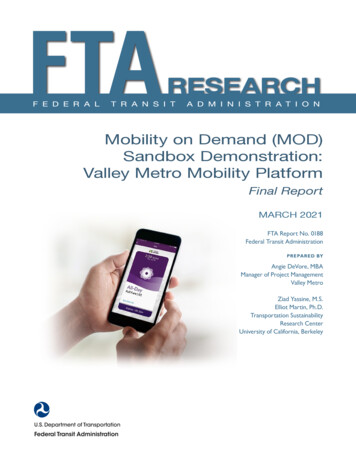
Transcription
Mobility on Demand (MOD)Sandbox Demonstration:Valley Metro Mobility PlatformFinal ReportMARCH 2021FTA Report No. 0188Federal Transit AdministrationPREPARED BYAngie DeVore, MBAManager of Project ManagementValley MetroZiad Yassine, M.S.Elliot Martin, Ph.D.Transportation SustainabilityResearch CenterUniversity of California, Berkeley
COVER PHOTOCourtesy of Valley MetroDISCLAIMERThis document is disseminated under the sponsorship of the U.S. Department of Transportation in the interest of informationexchange. The United States Government assumes no liability for its contents or use thereof. The United States Governmentdoes not endorse products or manufacturers. Trade or manufacturers’ names appear herein solely because they are consideredessential to the objective of this report. The opinions and/or recommendations expressed herein do not necessarily reflect thoseof the U.S. Department of Transportation.
Mobility onDemand (MOD)SandboxDemonstration:Valley MetroMobility PlatformFinal ReportMARCH 2021FTA Report No. 0188PREPARED BYAngie DeVore, MBA, Manager of Project ManagementValley Metro101 North First Avenue, Suite 1400Phoenix, AZ 85003Ziad Yassine, M.S.Elliot Martin, Ph.D.Transportation Sustainability Research CenterUniversity of California, Berkeley2150 Allston Way, #280Berkeley, CA 94704SPONSORED BYFederal Transit AdministrationOffice of Research, Demonstration and InnovationU.S. Department of Transportation1200 New Jersey Avenue, SEWashington, DC 20590AVAIL ABLE nnovationFEDERAL TRANSIT ADMINISTRATIONFEDERAL TRANSIT ADMINISTRATIONii
Metric Conversion TableSYMBOLWHEN YOU KNOWMULTIPLY BYTO mVOLUMEfl ozfluid bic feet0.028cubic metersm3yd3cubic yards0.765cubic metersm3NOTE: volumes greater than 1000 L shall be shown in short tons (2000 lb)0.907megagrams(or “metric ton”)Mg (or “t”)TEMPERATURE (exact degrees)oFFahrenheit5 (F-32)/9or (F-32)/1.8CelsiusoCFEDERAL TRANSIT ADMINISTRATIONFEDERAL TRANSIT ADMINISTRATIONiii
1.Form ApprovedOMB No. 0704-0188REPORT DOCUMENTATION PAGEThe public reporting burden for this collection of information is estimated to average 1 hour per response, including the time for reviewing instructions, searching existing data sources, gathering and maintaining the data needed, and completing and reviewing the collection of information. Sendcomments regarding this burden estimate or any other aspect of this collection of information, including suggestions for reducing the burden, toDepartment of Defense, Washington Headquarters Services, Directorate for Information Operations and Reports (0704-0188), 1215 Jefferson DavisHighway, Suite 1204, Arlington, VA 22202-4302. Respondents should be aware that notwithstanding any other provision of law, no person shall besubject to any penalty for failing to comply with a collection of information if it does not display a currently valid OMB control number.1. REPORT DATEMarch 20212. REPORT TYPEFinal3. DATES COVEREDJanuary 2017–December 20194. TITLE AND SUBTITLEMobility on Demand (MOD) Sandbox Demonstration: Valley Metro Mobility Platform,Final Report5a. CONTRACT NUMBER5b. GRANT NUMBER5c. PROGRAM ELEMENT NUMBER5d. PROGRAM NUMBER6. AUTHOR(S)Angie DeVore (Valley Metro), Ziad Yassine, Elliot Martin (UC Berkeley)5e. TASK NUMBER5f. WORK UNIT NUMBER7. PERFORMING ORGANIZATION NAME(S) AND ADDRESSE(ES)Valley Metro101 North First Avenue, Suite 1400, Phoenix, AZ 850038. PERFORMING ORGANIZATION REPORTNUMBERFTA Report No. 0188Transportation Sustainability Research CenterUniversity of California, Berkeley2150 Allston Way, #280, Berkeley, CA 947049. SPONSORING/MONITORING AGENCY NAME(S) AND ADDRESS(ES)U.S. Department of TransportationFederal Transit AdministrationOffice of Research, Demonstration and Innovation1200 New Jersey Avenue, SE, Washington, DC 2059010. SPONSOR/MONITOR'S ACRONYM(S)FTA11. SPONSOR/MONITOR'S REPORT NUMBER(S)12 . DISTRIBUTION/AVAILABILITY STATEMENTAvailable from: National Technical Information Service (NTIS), Springfield, VA 22161; (703) 605-6000, Fax (703) 605-6900,email [orders@ntis.gov]; Distribution Code TRI-3013. SUPPLEMENTARY NOTES NOTES [www.transit.dot.gov/about/research-innovation] tion][https://doi.org/10.21949/1520674 Suggested citation: Federal Transit Administration. Mobility on Demand (MOD) Sandbox Demonstration: ValleyMetro Mobility Platform, Final Report. Washington, D.C.: United States Department of Transportation, 2021. https://doi.org/10.21949/152067414. ABSTRACTValley Metro is actively communicating the value of transit in connecting communities and enhancing lives by exploring innovative solutions to bolster the customer experience and responding to changing values. Through the Mobility on Demand (MOD) Sandbox Program, FTAempowered Valley Metro to explore innovative business models and partnerships to deliver high-quality, seamless, and equitable mobilityoptions. Valley Metro’s MOD Sandbox Demonstration project, the Pass2Go pilot app, enables users the ability to pay for fares, plan trips, andobtain transportation information in a more convenient and customizable solution. This report discusses the project goals and evolution inaddition to key challenges and lessons learned during its planning and execution.15. SUBJECT TERMS Transit, multimodal trip planning, fare payment, mobile ticket purchasing, smartphone app, travel behavior impacts16. SECURITY CLASSIFICATION OF:a. REPORTUnclassifiedb. ABSTRACTUnclassifiedc. THIS PAGEUnclassified17. LIMITATION OFABSTRACT18. NUMBEROF PAGES4619a. NAME OF RESPONSIBLE PERSON19b. TELEPHONE NUMBERStandard Form 298 (Rev. 8/98)Prescribed by ANSI Std. Z39.18
TABLE OF CONTENTS1461015313637Executive SummarySection 1: IntroductionSection 2: Project DescriptionSection 3: Project EvolutionSection 4: EvaluationSection 5: Conclusions and ERAL TRANSIT ADMINISTRATIONiv
LIST OF igureFigureFigure4-5:4-6:4-7:4-8:4-9:21Figure 4-10:21Figure 4-11:22Figure 9:4-20:4-21:4-22:4-23:4-24:4-25:4-26:Day passes purchased through Pass2Go appTrip planning using Pass2Go appHousehold size distribution (Waves 1–3)Housing type distribution (Waves 1–3)Household income distribution (Waves 1–3)Highest education level distribution (Waves 1through 3 Waves 1–3)Race or ethnicity distribution (Waves 1–3)Vehicle ownership distribution (Waves 1–3)Transportation mode use distribution (Waves 1–3)Before/after change in transportation mode use (Waves 1–3)Change in planning times as a result of Pass2Go pilot(Waves 1–3)Change in wait times as a result of Pass2Go pilot(Waves 1–3)Change in access to public transit as a result of Pass2Go pilot(Waves 1–3)Change in use of on-demand transportation as a result ofPass2Go pilot (Waves 1–3)Household size distribution (Wave 4)Household income distribution (Wave 4)Highest education level distribution (Wave 4)Race or ethnicity distribution (Wave 4)Vehicle ownership distribution (Wave 4)Transportation mode use distribution (Wave 4)Change in planning times as a result of Pass2Go pilot (Wave 4)Change in wait times as a result of Pass2Go pilot (Wave 4)Effect of access to transit passes on public transit use (Wave 4)Use of Pass2Go in a different city (Wave 4)Impact of Pass2Go pilot availability (Wave 4)Pass2Go pilot used features (extended tester survey)Impact of Pass2Go pilot availability (extended tester survey)Impact of Pass2Go pilot on transportation mode use(extended tester survey)LIST OF TABLES13Table 3–1:Study Participation Results (Waves 1–4)FEDERAL TRANSIT ADMINISTRATIONv
ACKNOWLEDGMENTSThere were several contributors to this project and this report. ValleyMetro would like to thank WestGroup Research, including Kathy DeBoerand Stephanie Apostol, for their design and implementation of the study thatinformed the evaluation of this project. Valley Metro would also like to thankRoutematch, including Katie Charles and Rob Bryans, for their work toward theimplementation of the Pass2Go app and Transit Data Platform. WestGroupresearch made contributions to the survey questions, and UC Berkeley madecontributions leading the survey and evaluation design and data analysis. Finally,Valley Metro would like to thank the Federal Transit Administration for itsfunding and oversight of this project.ABSTRACTValley Metro is actively communicating the value of transit in connectingcommunities and enhancing lives by exploring innovative solutions to bolster thecustomer experience and responding to changing values. Through the Mobilityon Demand (MOD) Sandbox Program, FTA empowered Valley Metro to exploreinnovative business models and partnerships to deliver high-quality, seamless,and equitable mobility options. Valley Metro’s MOD Sandbox Demonstrationproject, the Pass2Go pilot app, provided users with the ability to pay for fares,plan trips, and obtain transportation information through a more convenient andcustomizable solution. This report discusses the project goals and evolution aswell as key challenges and lessons learned during its planning and execution.FEDERAL TRANSIT ADMINISTRATIONvi
EXECUTIVESUMMARYThe Federal Transit Administration (FTA) has led the Mobility on Demand(MOD) Sandbox Program aimed at exploring how new technologies can beincorporated to complement and support the traditional functions of publictransit. Valley Metro, the regional public transportation authority of MaricopaCounty, Arizona, was selected as one of 11 recipients of FTA’s MOD SandboxDemonstration projects. Valley Metro provides multimodal transit options,including regional bus and light rail systems, to the 4.25 million residents ofMaricopa County (US Census, 2018). It developed the RidekickTM mobileapplication (app) that functions as a basic trip planner for light rail and buses;however, the existing app had limited features and was not accessible forpeople with disabilities. Thus, the Valley Metro MOD Sandbox project, MobilityPlatform, was created to provide an updated version of the app with innovativefeatures. The Pass2Go app was designed to improve trip planning, provide amobile single ticketing and payment system, and connect users with multiplepublic and private transportation options.The envisioned project was planned in two phases—Phase I included developingPass2Go as a trip planner with real-time information and a single paymentsystem for public transit, and Phase II included integrating on-demand ridesourcing services into the mobile app environment. Phase II programming wascompleted for ridesourcing services; however, the project was unable to moveforward, as Lyft was not able to delegate the resources needed to move theprogramming into the mobile environment.The Valley Metro project had multiple objectives: Reducing trip planning, wait, and travel times.Encouraging the adoption of mobile-based technology for public transit.Improving first/last mile connectivity.Improving accessibility and trip planning methods for travelers withdisabilities. Enhancing the traveler experience. Providing an open data platform that allows transit agencies to exchangetravel information. Producing lessons learned for future projects.To test and evaluate user response to the Pass2Go app and its support tothe existing public transit system, Valley Metro contracted with WestGroup todevelop and implement a user survey. The study was set up in a series of fourthree-month waves in which participants in each wave were required to takea pre-study survey, use the Pass2Go app, and then take a post-study survey.An independent evaluation of the Valley Metro MOD Sandbox Demonstrationwas conducted under a separate contract with the U.S. Department ofTransportation (USDOT) to determine the success of the project in meetingFEDERAL TRANSIT ADMINISTRATION1
EXECUTIVE SUMMARYits objectives. Valley Metro and WestGroup collaborated with the independentevaluator throughout the project. Paired observations from both surveys as wellas app activity and payment data, the project’s open data platform, and insightsfrom expert (stakeholder/project partner) interviews were later used by theindependent evaluation team for analysis.Overall, the analysis showed that the Pass2Go app was an enhancement overthe existing RidekickTM app. Results showed that trip planning and wait timeswere reduced, real-time information for public transit and planning methods wereimproved, and accessibility was enhanced for travelers with disabilities.The project encountered some technical and contractual challenges. From amanagement perspective, it was important to reduce the size of the projectmanagement team to facilitate response time and gain consensus. However,a larger advisory group remained and was able to be involved and providefeedback about the project. There was no specified timeline to establish projectpartnerships, but it was noted that discussing strategies with potential partnersat the beginning of the project can be useful. This helps identify mutually-desiredobjectives with a clear assessment of individual control and responsibilities. Theproject’s open data platform allowed transit agencies to exchange informationand lessons learned which minimized duplication and increased productivity.With respect to project evaluation, producing sufficient and usable data wascrucial to conduct an accurate analysis. Documenting the data collectionand management approach in addition to regularly communicating with theindependent evaluator proved beneficial for this purpose. For future projects, itwould be best for the project’s team to conduct an initial review and analysis ofthe data followed by a more detailed analysis by the independent evaluator. Inaddition, the hiring of a professional market research team helped with collectingrepresentative data by identifying target participants that were willing to providedata throughout their ongoing participation.From an operational perspective, internal and external communication was a keychallenge to guarantee that different operators understood how the mobile ticketworked. For this purpose, Valley Metro conducted presentations and trainingsfor bus and rail operators and other members of the operations teams. Anotherchallenge was testing the developed accessibility features for both Android andiOS, for which a professional testing firm was hired. A technical support systemwas developed to report bugs and issues and track their resolution status.Although the fully accessible Pass2Go app enabled users to receive GeneralTransit Feed Specification (GTFS) information, plan their trips, and purchase ridepasses for public transportation modes, it did not successfully integrate nonValley Metro operated transportation services, such as Lyft and GR:D Bike Share,into a single payment system. The software development partner, Routematch,FEDERAL TRANSIT ADMINISTRATION2
EXECUTIVE SUMMARYformed a relationship with the Transportation Network Company (TNC)partner, Lyft, as there were significant concerns around data privacy and workingwith a government entity. After this relationship was established, Routematchreceived the application programming interface (API) keys and wrote theintegration to establish a single payment solution for both the transit ticket andthe Lyft ride cost. Unfortunately, Lyft was unable to move this into the mobileenvironment.Pass2Go was closed down, and the MOD Sandbox Demonstration ended inDecember 2019. Building on the experience and lessons learned with it, ValleyMetro and partner agencies are moving on to new developments to continueand expand on the functionality achieved during the project. Currently, the Cityof Phoenix has procured a new fare collection system with VIX and Unwire,which has an existing robust mobile app. The City of Phoenix and Valley Metroultimately opted to simplify the systems to use a single app that incorporatesmultimodal transportation options and real-time transit information in a singleticketing and payment system for different fare types. However, the lessonslearned from Pass2Go deployment will serve to inform this new venture andbuild upon its evaluated performance.FEDERAL TRANSIT ADMINISTRATION3
SECTION1IntroductionValley Metro is the regional public transportation authority providingcoordinated multimodal transit options to residents of greater Phoenix andthe Maricopa County urbanized areas in Arizona. Founded in 1993, the systemoperates a 38-station light rail line and over 100 bus routes, including 61 localroutes and 20 commuter express routes. With an annual ridership exceeding65 million rides per year, it is Arizona’s largest transit agency. Valley Metrofaces many of the first/last-mile challenges typical of transit agencies in thepresent day; it operates in an environment with relatively high auto ownershipand navigates the complexities of delivering transit services to a region thatspans multiple jurisdictions and land-use environments while trying to keeppace with the ever-advancing state of information technologies. Providingtransit services within this operational climate requires advancing the stateof practice with respect to customer interfaces. This includes improving thecapabilities of trip planning, payments, and first/last-mile connectivity.In May 2016, the Federal Transit Administration (FTA) announced an 8 millionPublic Transportation Innovation funding opportunity for Mobility on Demand(MOD) Sandbox Demonstrations. In October 2016, Valley Metro was selectedas one of 11 MOD Sandbox Demonstration projects, Mobility Platform.Valley Metro proposed the Mobility Platform project to address limitationswithin its existing mobile application (app), RidekickTM , which provides tripplanning for light rail and buses. Valley Metro sought to improve trip planningfeatures, including its accessibility for people with disabilities, and to developan integrated app-based payment mechanism for its public transit services andconnecting private transportation modes, such as Transportation NetworkCompanies (TNCs). The app developed and tested within this initiative wascalled Pass2Go .The project built on the functionality of the RidekickTM app through thedevelopment of features not previously available. These enhanced featuresincluded a fully-accessible transit app providing users with the ability topurchase tickets for public transit in addition to improvements to the tripplanning functionality. The broader objective of these enhancements wasto improve the level of connectivity and accessibility throughout the transitnetwork, decrease the first/last-mile challenges facing riders, and allowusers to more easily pay for and plan their trips on a mobile platform. Thesecapabilities within a mobile platform also produced useful data, and the mobileapplication permitted Valley Metro to measure ridership activity. Finally, theproject sought to improve connectivity with private transportation providers,FEDERAL TRANSIT ADMINISTRATION4
SECTION 1: INTRODUCTIONincluding TNC options. This included an effort to integrate connections withLyft, whereby users would be able to book Lyft rides from within the app.The project met most of its stated goals and delivered an improved appexperience to users within a test environment. One objective—integrationwith the TNC within the app—was attempted with considerable goodfaith effort but ultimately not achieved. The project was implemented andevaluated via surveys of users within four three-month waves. Three of thosewaves were used to inform results presented by an independent evaluationsponsored by the U.S. Department of Transportation (USDOT) and areincluded in this report. Selected preliminary results from the final wave arebriefly summarized, with additional analysis in this report. The waves requiredparticipants to use the app at least four times per month for three months andcomplete pre- and post-study surveys. This report provides project insightsfrom Valley Metro’s experience implementing the MOD Sandbox Project.In the sections that follow, the report details the project description andevolution, results from data collection and analysis, and key conclusions andlessons learned.FEDERAL TRANSIT ADMINISTRATION5
SECTION2Project DescriptionOverviewThe Valley Metro MOD Sandbox Demonstration project was designed around itsPass2Go app, which initially aimed to provide improved multimodal trip planning,first/last-mile connections, mobile ticketing and payment, incident reporting, and alink to other app-based transportation options.Valley Metro has provided a RidekickTM mobile application for its users that featurestrip planning for light rail and buses. The proposed Valley Metro Mobility Platformwas built on the existing functionality of RidekickTM by developing and testingfeatures not available to users. The initially-envisioned platform enabled users toreceive General Transit Feed Specification (GTFS) information, plan their trips, andpurchase ride passes for public transportation modes. The enhanced integrationwas planned to improve the level of connectivity throughout the transit network,decrease the first/last-mile challenge facing public transportation users, and allowthem to smoothly complete their trips from origin to destination all within a fullyaccessible app. It was also planned to incorporate private ride sourcing services intothe mobile application through its own application programming interfaces (APIs).Thus, the project was divided into two phases—Phase I included developing theapp as an accessible trip planner that supports mobile ticketing and shows nearbytransit stops, and Phase II included the integration of GTFS data for public transit ina fully-accessible application. Devices that support real-time travel information wereinstalled on transit buses; however, that information was not publicly available at theconclusion of this project. Also, in Phase II, a multimodal trip planning feature wasplanned to provide links to GR:D BikeShare, Lyft, and Uber. The Lyft integrationcode was written but not executed, as Lyft was unable to move the programminginto the mobile app environment. Additionally, incident reporting (e.g., passengermisconduct, disruptive behavior, illegal activity) via the app was discussed withLiveSafe, but LiveSafe was not able to make the features work on the scale needed.Project GoalsThe Valley Metro MOD Sandbox Project had a number of objectives: Reducing traveler trip planning, wait, and travel times. Encouraging adoption of mobile-based technology and reducing the amount ofpaper-based tickets and onboard cash pay. Improving first/last-mile connectivity. Improving accessibility of the mobile app and enhancing trip planning methodsfor travelers with disabilities. Enhancing the customer experience through improved traveler information.FEDERAL TRANSIT ADMINISTRATION6
SECTION 2: PROJECT DESCRIPTION Providing an open data platform that allows transit agencies to view andexchange travel information. Producing lessons learned and recommendations for future projects throughexpert (stakeholder/project partner) interviews.Project InformationProblem AddressedValley Metro provides multimodal transit options to about 4.25 million residents.It plans and operates regional bus and light rail systems and has provided theRidekickTM mobile application as a trip planning tool for travelers. However, theapplication was noted for having limited trip-planning features for multimodal trips,and it was not accessible for some people with disabilities. Travelers would needto access different mobile applications to plan, use, and pay for a multimodal tripfrom their origin to their destination. Thus, Valley Metro envisioned a new mobileapplication, Pass2Go , as an accessible trip-planning platform providing real-timetransit information with public and private transportation options in addition to anintegrated payment system. This aligned with the primary objective of the MODSandbox initiative to incorporate new technologies that complement and supportthe traditional functions of public transit.Valley Metro launched and deployed the Pass2Go app to develop, test, andevaluate user response to the integration of these features into the Valley Metropublic transit system. The app was designed to provide users with trip-planningcapabilities and allow them to purchase transit tickets. Figure 2-1 and Figure 2-2provide example screen shots of key app functionalities.Figure 2-1Day passes purchasedthrough Pass2Go appFEDERAL TRANSIT ADMINISTRATION7
SECTION 2: PROJECT DESCRIPTIONFigure 2-2Trip planning usingPass2Go appThe project was divided into Phase I and Phase II. Phase I was deployed in2018, and Phase II was delayed and ultimately not fully implemented due tounanticipated challenges. Minor app improvements implemented in PhaseII included accessibility fixes, addition of group passes, simplified checkoutprocess for saved cards, a next-ride feature, and interface updates.Valley Metro contracted with WestGroup Research to develop and implementa series of surveys in four waves. Each wave was designed as a before-andafter survey implemented over successive periods of three months. Duringthese waves, respondents were recruited, invited to take a before survey inthe beginning, use the Pass2Go app, and then take an after survey at theend of the three-month period. Waves 1 through 3 took place in Phase I, andwave 4 took place in Phase II. Data from the waves was compiled, and theindependent evaluation team received and analyzed the data in accordancewith an evaluation plan for the purposes of completing an independentevaluation.OutcomesEvaluation of Phase I of the project showed that the Pass2Go pilot app wasan enhancement over the existing RidekickTM app. The analysis, presentedFEDERAL TRANSIT ADMINISTRATION8
SECTION 2: PROJECT DESCRIPTIONin the independent evaluation report and based on 12 hypotheses, showedthat the project reduced user waiting and planning times, enhanced theirtrip planning methods and access to real-time information, and improvedtheir accessibility and connectivity to multiple transportation options. Also,the platform allowed Valley Metro and WestGroup Research the ability toexchange travel information and produce lessons learned for future projects.FEDERAL TRANSIT ADMINISTRATION9
SECTION3Project EvolutionBefore the MOD Sandbox project, Valley Metro provided the RidekickTMmobile application as a trip planning tool for travelers, and it was still theprimary public facing app of Valley Metro during the project. Valley Metrodeveloped the idea for the improved Pass2Go mobile application withadditional features and engaged various stakeholders about its development,including the Maricopa Association of Governments (MAG) and the City ofPhoenix. Over time, stakeholder engagement and coordination evolved acrossthe agencies at multiple levels. The process eventually involved approximately60 people wanting to be part of the planning process. Valley Metro realizedthat the size of the project management team was becoming large and assignedthe effort to a smaller project management team with a larger advisorygroup that could still be involved and provide feedback in the Pass2Go development.The project faced a tough start, as partners were overly optimistic on the timeneeded to address several technical challenges. Valley Metro and Routematch,the project’s technology partner and app developer, had established anambitious timeline for the project. One of the challenges presented by thetimeline was meeting its goals while maintaining the rigors required of the appdevelopment cycle and all its required steps. For the app development process,it was important to research integration points such as payments, next stops,and trip planning to ensure compatibility. Certain safety and security features,such as the integration with the LiveSafe app allowing passengers to reportincidents as they were in progress or request assistance from the OperationsControl Center (OCC), were dropped because of challenges with softwarelimitations surrounding the size and scope of the geographic area.It was clear very early on that a third party would be needed to confirm orprovide feedback on accessibility improvements, including confirming theimplementation of a number of features or functional attributes (called SuccessCriterion), as listed below: Name, Role, Value – To ensure that assistive technologies (AT) can gatherinformation about, activate (or set) and keep up-to-date on the status of userinterface controls in the content. Contrast (Minimum) – To provide enough contrast between text and itsbackground so that it can be read by people with moderately low vision. Keyboard – To ensure that, wherever possible, content can be operatedthrough a keyboard or keyboard interface (so an alternate keyboard can beused).FEDERAL TRANSIT ADMINISTRATION10
SECTION 3: PROJECT EVOLUTION Focus Visible – To help a person know which element has the keyboardfocus. Focus Order – To ensure that when users navigate sequentially throughcontent, they encounter information in an order that is consistent with themeaning of the content and can be operated from the keyboard.One goal of the project was to incorporate the use of paratransit serviceinto the app, but a challenge was that Valley Metro does not have oversightof paratransit throughout the area. Due to these technical and jurisdictionalcomplexities, the paratransit features
Mobility on Demand (MOD) Sandbox Demonstration: Valley Metro Mobility Platform Final Report MARCH 2021. . National Technical Information Service (NTIS), Springfield, VA 22161; (703) 605-6000, Fax (703) 605-6900, email [orders@ntis.gov]; Distribution Code TRI-30 14. ABSTRACT:
